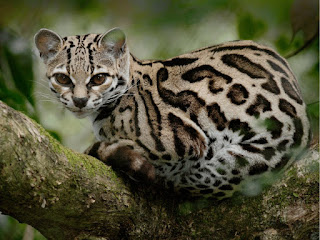
The margay is a small wild cat native to Central and South America. As a solitary and nocturnal cat, it lives mainly in evergreen and deciduous forests. Until the 1990s, Margays were illegally hunted for the wildlife trade, resulting in a sharp population decline. This animal can be found in Mexico, Central and South America (near the Amazon and in Argentina, Uruguay, Belize, and Brazil). Margay is a shy animal who avoids humans and the exact number of wildlife is unknown.
Margay is a small cat that usually weighs between 9 and 20 pounds and reaches between 18.2 and 31 inches in length. Males and females look alike.
Its head, neck and throat have black lines, and behind the ears they are black with a white spot in the center.
Margay has very long tail that is used for balancing. It can be 20 inches long, which equals the length of the 70% of the body.
The cat’s fur is relatively soft and thick, and, unusually, grows “in reverse” on the back of its neck, instead, slanting forwards.
Margay’s fur can be grayish to cinnamon in color. It is covered with black-ringed rosettes.
Males and females are similar in size and appearance.
Margay has large eyes adapted to night vision, because margay is nocturnal (active at night) animal.
Margays hunt and travel mostly while on the ground.
Margay’s diet consists of small mammals such as squirrels, opossums, small monkeys, sloths, porcupines, tree frogs, lizards and birds. It consumes fruit rarely.
Margays, like most cats, are territorial.
Margay is adapted for arboreal (life in the trees) life style. It can easily leap from one branch to another. Also, margay is able to hang from the branch by holding it with only one paw.
They mark their territory with urine, and secretions that come from scent glands between their toes and on their faces.
Unlike other cats, margay is able to move down the tree, with its head going before feet (like squirrels). This is possible because it has flexible ankles of the front feet that can be rotated for 180 degrees.
Margays eat a wide variety of prey, including both terrestrial and arboreal mammals, birds, birds’ eggs, reptiles, amphibians, arthropods, and fruit.
Margays are serially monogamous animals, forming temporary pair bonds during the mating season.
Because it spends most of its time in the treetops, margay is also known as “tree ocelot”.
The natural mating season goes from October to January, though it may be year-round in the deep tropics.
Margays are solitary creatures. Their territory may range from 15 to 43 square kilometers.
The Margay kittens open their eyes when they are about two weeks old, and begin to go outside the den at around five weeks old.
Margays that live in tropical region can mate throughout the whole year. Those that live in temperate climate will mate seasonally.
According to the IUCN Red List, this species is predominantly uncommon to rare throughout its range.
Pregnancy in females lasts between 76 and 84 days and it ends with one or two kittens. Mother keeps the babies hidden in a den made in the hollow tree or in the underground burrow.
When jumping over distance, margays fling all of their four legs out, as a squirrel does. Their long tail and their large paws help to keep balance.
Spots on their fur are present from the moment of birth. Young margays open their eyes two weeks after birth.
Only margays and clouded leopards have enough flexibility of their ankles to facilitate climbing down trees head first.
Kittens leave the den for the first time when they reach the age of five weeks. They will continue suckling for three more weeks. After that period, they are ready to eat meat just like adult animals.
Instead of stalking prey, the margay likes to lie in ambush for prey.
Margays reproduce slowly. Female gives birth every two years, litter size is small and mortality of babies is very high (50%).
The spots on the fur of margay kittens are present when they are born.
Margay can survive less than 10 years in the wild and up to 20 years in captivity.








